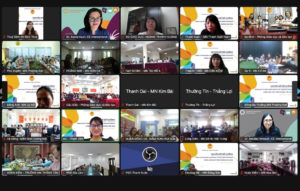ECE Leadership Training in Vietnam


CE International partnered with the Ministry of Education and Training in Vietnam (DOET) to deliver a two-day intensive leadership training for early childhood educators on leadership, quality improvement, and strategic education planning. Approximately 2,500 participants attended this unique event in small-group settings across the country, thanks to the incredible logistical support from the DOET team in Hanoi. The ECE leadership training sessions were delivered by a team from CE International. Dr. Amlata Persaud and Dr. Samia Kazi, supported by Michelle Allen, worked with the DOET team to customize sessions that enabled Vietnamese leaders currently overseeing public kindergartens to strengthen their leadership and strategic planning capabilities. In this article, we will share some lessons learned during the delivery of this project.
Meet Learners Where They Are
The training consisted of three modules: Innovations in Early Childhood Leadership, Adapting Global Guidelines for Quality Early Childhood to the Vietnamese Context, and Strategic Planning for Early Childhood School Leaders.
Vietnamese early childhood leaders benefit from an existing national quality framework and are required by the government to prepare strategic plans for their kindergartens. Therefore, this ECE leadership training was designed to extend leaders’ knowledge in these areas, respond to current challenges, and provide participants with practical exercises to help them improve their strategic early education planning skills.
Learning About the Learners
One challenge frequently encountered by trainers working with learners in different countries is constructing a solid understanding of their unique contexts, both from a macro-perspective and also from the perspective of participants’ own professional and personal experiences and insights. With that in mind, the CE International team dedicated a significant amount of time to meeting with the team in Hanoi in order to learn more about the historical and socio-political background of early childhood in the country, and understand the particular needs and experiences of the intended participants. We also requested and received a cache of translated documents that helped greatly to deepen our understanding of the early childhood setting and schools in Vietnam. Finally, we prepared a pre-training survey for participants to gather information about them that was helpful to us in designing the training as well as in engaging with them during delivery. We asked questions about their professional backgrounds and experiences, and were also able to gain insights into their own assessment of skills and capacities, challenges they currently faced, and their feelings about the topics we would be covering during the training sessions. This combined and intentional approach to learning more about the learners helped to strengthen the quality and relevance of the training offered, and bridged some of the distance we may feel when connecting with participants in virtual settings.
 Prepare for Plan B
Prepare for Plan B
Participants attended the live training sessions via Zoom from 10 different locations across the country. These large-group gatherings created wonderful opportunities for discussions and networking among participants but also presented risks related to connectivity and technical delivery of the program. The CE International team pre-recorded all the lecture content for the sessions, prepared detailed learner workbooks, and provided every learner with the translated videos, slides, workbooks, and accompanying resources to ensure no learner was left out and they could engage with the material through multiple formats.
Be Flexible During the Sessions
Training facilitators often want to have a predetermined training plan. We spent time creating training “flows,” and identifying the exact number of minutes learners will spend on each activity and section of this ECE leadership training. However, we know how important it is to be flexible; as early childhood educators, we allow children to spend more time on areas that engage them or try to add a new challenge to an activity when we see possible extension. Implementing this strategy in adult training can have similar benefits. We actively listened to and observed the participants and requested feedback from group leaders; with that information, we made minor changes to activities and timelines when comfortably possible.
As an example, in response to our assessment of the participant set-up and engagement, as well as listening to feedback from the organizers in Hanoi, we reworked our approach for the second day of the training session. We opted for a live presentation of our material instead of pre-recorded lectures, giving us the opportunity to pause and invite reflections and discussions. We also developed and included a new activity for the second day’s session, after spending the first day assessing participants’ interest and engagement in our planned activities. The new activity attracted great participation and received a lot of positive feedback, illustrating the value of being responsive and flexible in real-time delivery of training sessions.
Through the use of simultaneous translation for the live sessions, translations of written material, and Google translation for messages in the Zoom chat, we were able to connect and engage with thousands of early childhood leaders and professionals in Vietnam. Despite the barriers of language and distance, we were once again reminded that all early childhood leaders face similar challenges and share the same values and objectives of serving our children, communities, and providing the best experiences to our future global citizens.